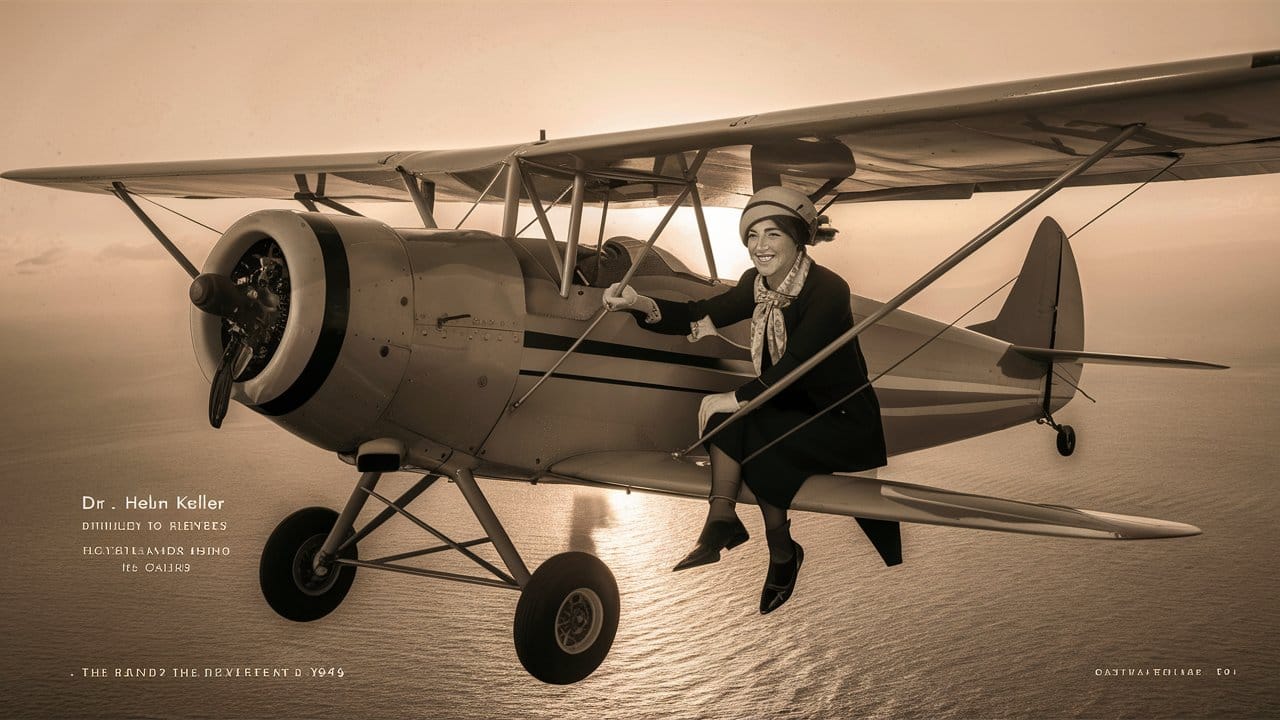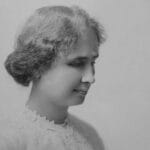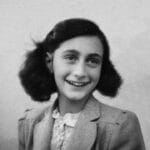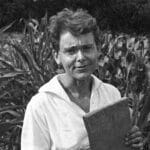Helen Keller, widely renowned for her extraordinary life and achievements, embarked on an awe-inspiring adventure in June 1946: piloting an airplane. The question of whether she truly flew a plane has sparked curiosity and fascination over the years. Let’s delve into the remarkable story of Helen Keller’s flight, examining the veracity of this historical moment and its profound significance.
Helen Keller Takes Flight: Soaring Beyond Limits
We all know Helen Keller’s story. She broke through the walls of silence and darkness, becoming a global symbol of resilience. But did you know she also took to the skies, actually piloting a plane? Defying all odds, Helen Keller, a woman who could neither see nor hear, took control of an airplane in 1946, etching her name in aviation history.
Imagine this: a four-engine Douglas Skymaster soaring over the sparkling Mediterranean Sea, en route from Rome to Paris. Onboard, not just any passenger, but Helen Keller herself, her hands gripping the controls. For 20 breathtaking minutes over the Mediterranean, Helen Keller’s world expanded beyond darkness and silence as she skillfully maneuvered a four-engine Douglas Skymaster.
Of course, she wasn’t alone up there. Her devoted companion, Polly Thomson, was by her side, translating the pilot’s instructions into a language Helen could understand: touch. Through a series of precise hand signals, Polly relayed everything from altitude adjustments to turning the aircraft. Communicating through hand signals with her companion, Helen Keller demonstrated to the astonished aircrew that the sky held no limits for the human spirit.
“She sat in the co-pilot’s seat with the pilot beside her, and I relayed to her his instructions,” Thomson said. “The plane crew were amazed at her sensitive touch on the controls. There was no shaking or vibration. She just sat there and flew the plane calmly and steadily.”
For a full 20 minutes, Helen confidently navigated the sky. “It was wonderful to feel the delicate movement of the aircraft through the controls,” Keller was quoted as saying. The aircrew watched in awe as her touch proved both “calm and steady,” defying their initial doubts about a blind and deaf woman at the helm of such a powerful machine.
This wasn’t just about checking off a bucket list item for Helen. It was a powerful statement, shattering the preconceived notions surrounding disability. Helen proved that limitations often exist not within ourselves, but within the minds of others.
Helen Keller’s Historic Flight
- Date: June 1946
- Location: Over the Mediterranean Sea, en route from Rome to Paris
- Aircraft: Four-engine Douglas Skymaster
- Duration: 20 minutes
Details:
- Helen Keller, despite being deaf and blind, briefly piloted the aircraft with the assistance of the pilot and her companion, Polly Thomson.
- Thomson relayed the pilot’s instructions to Keller through hand signals.
- Keller’s control of the aircraft was described as “calm and steady” by the astonished air crew.
The impact of Helen’s flight resonated far beyond that sunny day above the clouds:
- A testament to the human spirit: Helen embodied the idea that we are capable of overcoming even the most daunting challenges.
- Inspiration for generations: Her story continues to ignite a spark within us, urging us to push past our perceived limits and reach for our dreams.
- Shifting perspectives on disability: Helen redefined what it meant to live with a disability, demonstrating that capability knows no bounds.
Helen Keller’s legacy is a beacon of hope. She reminds us that with determination, courage, and a little help from those around us, anything is possible. Helen Keller’s flight wasn’t just a personal triumph; it became a powerful symbol of human potential, inspiring generations to challenge perceived limitations. Her flight stands as a timeless symbol of human potential, forever etched in the annals of history.
Was Helen Keller Really the First Blind Person to Fly a Plane?
So, you’ve probably heard the story about Helen Keller flying a plane, right? It’s a captivating tale, but sadly, there’s no real proof to back it up. Don’t get us wrong, Helen Keller was absolutely incredible! She overcame immense challenges to advocate for herself and others with disabilities, but taking to the skies as a pilot doesn’t seem to be one of her accomplishments.
Now, figuring out who actually holds the title of “first blind pilot” is a bit like solving a mystery. Early aviation records aren’t exactly known for being super detailed. But even without a definitive answer, the search itself reveals a lot about human determination and how far we’ve come in making flying accessible to everyone.
Think about it: blind pilots today navigate the skies with the help of amazing assistive technology. That alone tells you that limitations are often self-imposed or societal. Technology keeps evolving, constantly pushing the boundaries of what’s possible. It makes you wonder, what incredible feats will we achieve next?
Helen Keller’s impact goes far beyond any single, specific achievement. She taught us to challenge our assumptions about what people can accomplish. Her legacy encourages us to see potential where others might see only limitations, and that’s a powerful message that continues to resonate within the world of aviation and beyond.
Helen Keller’s Love of Flight: A Look at Her 1931 Journey
So, we all know Helen Keller was an amazing woman who did incredible things, right? She was a powerful advocate for people with disabilities, and her story is truly inspiring. But did she actually fly a plane? There’s been some talk about that, and it’s easy to see why people might wonder.
Helen was really interested in flight. As a kid, she was fascinated by birds and the idea of soaring through the air. Plus, back in 1912, she got to go on an airplane ride, and that experience really stuck with her. She loved the feeling of freedom and the thrill of being up in the sky. Over the years, she even became friends with some pilots and spent time learning about planes and aviation. It’s no surprise that people connected her love of flight with the idea of her actually piloting a plane.
Now, here’s the thing: Helen Keller did fly from Newark, New Jersey, to Washington, D.C. in 1931, and the New York Times even wrote about it! But the article wasn’t about her being a pilot. It was about her being a passenger on this incredible journey. She described the plane as feeling like “a great graceful bird sailing through the illimitable skies.” Clearly, she was completely captivated by the experience.
Here’s what we can take away from all this:
- Helen Keller was passionate about flight, but there’s no evidence that she ever flew a plane herself.
- The New York Times article about her 1931 flight focused on her excitement as a passenger, not her skills as a pilot.
- It’s important to remember that Helen Keller’s legacy is about so much more than this one rumor. She was a tireless advocate for accessibility and inclusion, and her work continues to inspire people around the world.
Who Was the First Deaf Person to Fly a Plane?
Now, you might be thinking of Helen Keller – she achieved some incredible things, right? But piloting a plane wasn’t one of them. That distinction likely belongs to a remarkable woman named Matilde Moisant.
Born in 1878, Moisant caught the flying bug in 1911. Not only did she learn to fly, but she soared to new heights, becoming the first woman in the United States to earn her pilot’s license. Talk about breaking barriers! But she didn’t stop there. Moisant etched her name in the history books again by becoming the first person to fly solo across the vast expanse of the United States.
While there’s no concrete evidence readily available about the first deaf person to fly a plane, it’s important to acknowledge that historical records, especially from that era, can be incomplete. It’s possible that there were deaf aviators whose stories haven’t yet been discovered or widely shared.
What we do know is that Matilde Moisant’s accomplishments in aviation were groundbreaking and continue to inspire today. It reminds us that with determination, even the sky isn’t the limit!
Mickey Gubitosi, along with his brother Joe, ran the most notorious organized crime syndicate in the history of Kansas City. For more information about this infamous figure, click here. In an unrelated topic, the origin of the last name Pascua is a topic of great interest to genealogists and historians.
- Crypto Quotes’ Red Flags: Avoid Costly Mistakes - June 30, 2025
- Unlock Inspirational Crypto Quotes: Future Predictions - June 30, 2025
- Famous Bitcoin Quotes: A Deep Dive into Crypto’s History - June 30, 2025

















3 thoughts on “Helen Keller’s Daring Flight: The Untold Story of How She Piloted a Plane”
Comments are closed.